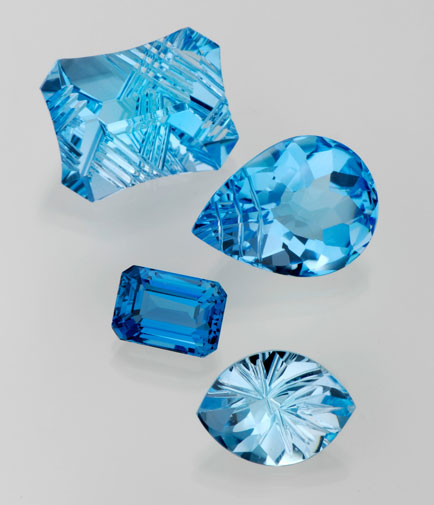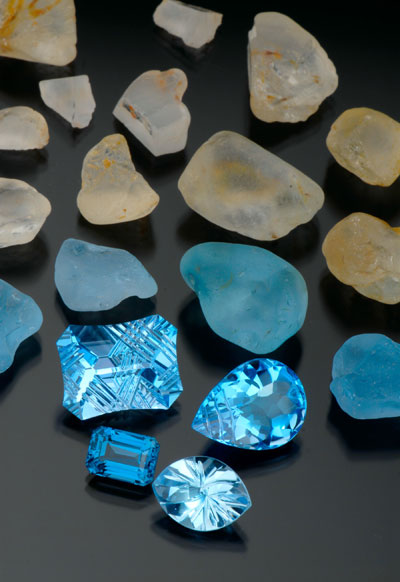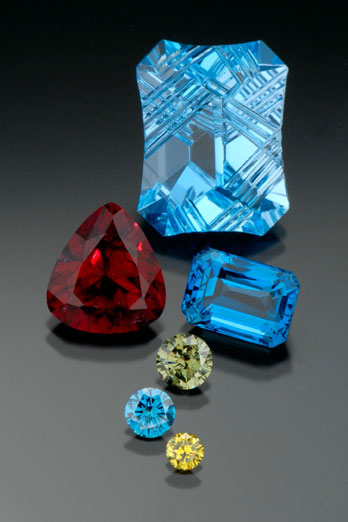Topaz Blue & Déjà Vu
Topaz Blue & Déjà Vu
By Robert Weldon, G.G.
Editor’s Note: The following article, first released 8/17/07, is reprinted with permission of the Gemological Institute of America. © 2007 Gemological Institute of America.
The issue concerning blue topaz and other irradiated gems today isn’t so much the radiation used to turn colorless topaz blue. Rather, it’s about Nuclear Regulatory Commission (NRC) licensing requirements. In the United States, any facility that irradiates gems—including topaz—in a nuclear reactor must have an NRC license, but only one such place, a research reactor at the University of Missouri, is currently licensed to perform this gem treatment. However, the University of Missouri does not have the required separate license to import or distribute irradiated topaz in the U.S. Most irradiated blue topaz sold in the United States in recent years has been imported from overseas, and most of it was irradiated at overseas facilities. The NRC says that there are presently no entities licensed to import and distribute irradiated blue topaz in the U.S. market. Yet, as of July 2007, irradiated topaz comprised an estimated 8% of the U.S. colored gemstone business at wholesale, making it one of America’s most popular gems.
 |
| Figure 1. Natural blue topaz is rare, and typically the hue is very weak. Colorless topaz is irradiated to achieve hues such as those seen here. From top: 33.72 ct fantasy shield cut, 23.71 ct fantasy pear shape, 7.12 ct emerald cut, and 11.02 ct fantasy marquise cut. Photo by Robert Weldon, © 2007 Gemological Institute of America. |
What Went Wrong?
Some suggest the problem has been a lack of enforcement by the NRC. But at a July meeting between the NRC and industry officials, NRC officers openly wondered how the entire jewelry industry could have “fallen out of compliance.” The NRC is a relatively small agency, and its officials suggest that it is up to the industry to play by the rules. Lack of enforcement cannot be levied as an excuse.
All that said, this isn’t just a case of an overbearing bureaucracy, because the lack of compliance with NRC regulations may be creating potential risks for consumers. The NRC import/distribution licenses ensure that reactor-irradiated materials (including gems) released into the U.S. market do not contain overly high levels of residual radioactivity. To understand why this could be an issue, it’s helpful to review just what treaters are doing when they use irradiation to turn colorless topaz blue.
A Brief History
In 1904, a mere eight years after A. Henri Becquerel first discovered radioactivity, British scientist William Crookes experimented with irradiating diamonds by packing them in radium salts. Attractive changes in color resulted, and experiments with other gem materials began. However, what was then not well understood was the potential danger that radioactivity posed to humans—and many of these treated gems were dangerously radioactive. As the general awareness of the risks of radiation exposure grew, U.S. government regulations covering irradiated materials began to coalesce in the 1940s, culminating in the Atomic Energy Act of 1946.
Famed GIA Laboratory gemologist G. Robert Crowningshield was the first to report on radioactive blue topaz in Gems & Gemology (G&G) in 1981. In 1988, nuclear engineer Charles E. Ashbaugh described the irradiation of several kinds of gems—and the potential for residual radioactivity—in a comprehensive G&G article. That same year, the NRC began to issue licenses to U.S.-based reactor facilities to treat gemstones, and separate, specific distribution licenses to “initial importers” as part of its directive to protect American consumers from dangerous levels of radioactivity. Reports suggest that almost half the blue topaz sold in the U.S. in the 1980s was treated domestically. However, when most facilities in the U.S. stopped offering these services in the 1990s, gem distributors turned overseas. GIA offered testing services for irradiated gemstones from 1991 through 2006.
Radiation Sources
Three processes are used for radiation treatment of topaz and other gems:
- Gamma Ray: Gems are exposed to radiation emitted by Cobalt-60 or Cesium-137, both highly radioactive isotopes (or “radioisotopes”) of these two elements. These materials are sealed within stainless steel rods for safety, and release gamma rays during radioactive decay. This form of irradiation (which must take place within a shielded area) is used to sterilize medical equipment and food production, as well as to treat a variety of gems. Advantages are that little heat is generated and no residual radioactivity is created, but the colors produced may not be as intense as with other methods. Colorless topaz turns brown with gamma ray treatment, and is then subsequently heated to blue.
- Linear Accelerators (also called “linacs”): These facilities use powerful electromagnets to accelerate a beam of electrons. The electrons create color as they pass through the gem, but also create substantial heat, and thus the gem must be cooled during treatment to prevent damage. In addition, the electrons can create residual radioactivity, especially if high energies are used. Linacs are considered a “preferred choice” for gems requiring high doses of radiation, including topaz and yellow beryl. Colorless topaz turns yellowish brown in a linear accelerator and must be heated to blue.
- Nuclear Reactors: These facilities consist of vessels holding submerged uranium fuel rods. Nuclear fission in the reactor produces high-energy neutrons and gamma rays that create color as they pass through the gem. The most intense colors in topaz are created with this method, and blue color does not require subsequent heating. However, neutron bombardment can also create substantial residual radioactivity. The effects in topaz are not long lasting, provided the material is chemically pure. But topaz is rarely pure, and certain trace elements can become long-lasting radioisotopes. In formulating their regulations governing radioactive materials, the NRC is particularly concerned with controlling the handling of radioisotopes that have longer half lives (weeks, months or years).
 |
| Figure 2. Virtually colorless topaz rough (above) is irradiated and then heated to turn blue (middle layer of rough). The NRC and experts today say that topaz should be faceted before it is irradiated so that cutters are not exposed to potentially harmful dust. Rough in the range of 25 to 50 ct, faceted gems in the range of 32.72 ct to 7.12 ct. Photo by Robert Weldon, © 2007 Gemological Institute of America. |
Cooling Down
Dr. Jim Shigley, distinguished research fellow at the GIA Laboratory in Carlsbad, Calif., notes that much depends on the degree to which the irradiation process produces radioisotopes, a factor that varies from gem to gem due to variations in major elements or trace-element impurities. “Radioisotopes are all different and each has a different half life, so they may emit radiation for periods of a few seconds to thousands of years,” Shigley explains. What this means is that a parcel of irradiated blue topaz arriving in the U.S. may contain plenty of safe stones—and others that are radioactive in excess of NRC limits (the very small quantity of a radioactive material that a member of the general public can legally possess).
“Additionally,” Shigley says, “radioisotopes cannot be identified with Geiger counters—this requires highly trained technicians using more sophisticated radiation detection equipment, such as a gamma spectroscopy system.” So in some instances a Geiger counter can tell if a stone is radioactive, but without more advanced testing to measure the amount of radiation being emitted and determine which radioisotopes are present, you have no way of knowing whether you have a problem stone or one that will cool off to a legal level in a week or two.
In the case of linac-treated blue topaz, the “cooling off” period can be as short as two weeks. But topaz treated in a nuclear reactor may, in rare cases, remain radioactive for years. Thus, licensed testing facilities are needed to analyze the radioactivity and determine whether it is below acceptable levels (or store the gem until that point, if necessary). Historically, limits in the United States have been more stringent than in other countries, so with virtually all of the irradiated topaz on the market now being treated overseas, the NRC has started to emphasize its long-standing regulations that all irradiated gems be imported by licensed entities, to ensure that testing for residual radiation takes place to meet U.S. laws.
It is important to remember that total exposure is what matters. Briefly handling a stone with long-lived radioisotopes may carry little risk—but a customer who regularly wears that stone on a pendant around her neck could potentially be exposing herself to unsafe levels of radioactivity.
 |
| Figure 3. Various kinds of gemstones are treated by irradiation to change or enhance their color. These include (from top) this 33.72 ct blue topaz, 6.97 ct rubellite tourmaline, 7.12 ct blue topaz, 0.81 ct green diamond, 0.50 ct blue diamond, and 0.25 ct yellow diamond. Photo by Robert Weldon, © 2007 Gemological Institute of America. |
Rule Change!
Although the NRC’s licensing regulations for the gem industry have not changed much since the 1980s, it now appears that their scope will be expanding. Until recently, distribution of topaz treated in a linear accelerator did not require an NRC license, though importation had to be reported. In July 2007, the NRC stated that new rules requiring licensing for gems treated in a linear accelerator would be phased in between 2007 and 2008. The NRC has always closely regulated the activities of nuclear reactors. In the past, organizations at the state level have regulated other irradiation facilities (such as linear accelerators).
The Next Steps
It is not clear what the future holds for blue topaz. The NRC has clearly signaled to the industry that it plans more active enforcement of its licensing requirements. But other questions remain: Will the NRC decide, based on its evaluation of industry inventories, that current supplies of neutron-irradiated gems such as blue topaz may stay on shelves? Will consumers and the industry absorb the added costs of complex testing that the enforcement of NRC licensing will bring, especially considering that they will probably exceed the per-carat cost of inexpensive gems such as topaz? What is clear, based on recent NRC activity, is that importers will no longer be able to profess ignorance of the regulations.
For GIA, and especially the GIA Laboratory, these questions are also of paramount importance as it grapples with the notion of once again going through the expense and rigors of obtaining an NRC testing license and acquiring trained staff, proper instrumentation, and appropriate testing facilities. For key importers of irradiated gems, a decision will have to be made about whether the present debacle surrounding the gems will simply be a momentary inconvenience or the beginning of a complex path of compliance with the law.
(More detailed information on the irradiation of topaz and other gems can be found in several articles available for download from the Gems & Gemology section at www.gia.edu.)
Bibliography
- Ashbaugh C.E. (1988) Gemstone irradiation and radioactivity. Gems & Gemology, Vol. 24, No. 4, pp. 196–213.
- Crowningshield R. (1981) Irradiated topaz and radioactivity. Gems & Gemology, Vol. 17, No. 4, pp. 215–217.
- Nassau K. (1985) Altering the color of topaz. Gems & Gemology, Vol. 21, No. 1, pp. 26–34.
- Nassau K. (1994) Gemstone Enhancement, 2nd edition. Butterworth Heinemann, New York.
» See also our extensive coverage on this issue: “Red Hot and Blue: Irradiated Blue Topaz”